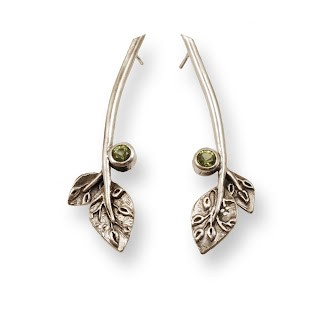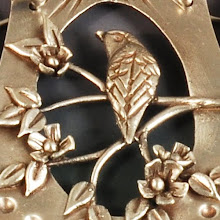 |
| Rock Rose Trapeze earrings ©2013 Vickie Hallmark sterling silver |
 |
| Rock Rose Long Drrop earrings ©2013 Vickie Hallmark sterling silver |
 |
| Rock Rose Swing earrings ©2013 Vickie Hallmark sterling silver |
 |
| Rock Rose Trapeze earrings ©2013 Vickie Hallmark sterling silver |
 |
| Rock Rose Long Drrop earrings ©2013 Vickie Hallmark sterling silver |
 |
| Rock Rose Swing earrings ©2013 Vickie Hallmark sterling silver |
This morning I finished the Periodot Leaf Bud earrings that have been sitting on my bench for literally months.
 |
| Peridot Leaf Bud earrings ©2013 Vickie Hallmark sterling silver & peridot |
 |
| Garnet Leaf earrings ©2013 Vickie Hallmark sterling silver & almandine garnet |
A few weeks ago, I wrote about my design process for a custom ring. That post detailed how I start with an idea, develop the drawings, and convert them to texture plates. Finally, I'm happy to report that the design has been reduced to metal.
 |
| Canary Ring sterling silver ©2013 Vickie Hallmark |
 |
| Canary Ring, back sterling silver ©2013 Vickie Hallmark |
 |
| Canary Ring sterling silver ©2013 Vickie Hallmark |
It's interesting to sit and make bird after bird by hand from metal clay. Detailed observations are required. What poses look natural? How do I fit enough detail into a tiny half inch bird with just my fingers and a few simple tools? Which details are crucial; which can be omitted? Simplify, simplify, I repeat to myself.
I'm known for my bird themed jewelry, where each bird is hand-formed individually just as nature would do it. Unfortunately, there's a lot of work involved in sculpting a half inch bird by hand from a pea sized lump of metal clay. That limits the amount of jewelry that I can produce. Many people over the years have suggested that I mold my birds and reproduce them. I've always resisted. Until now.
 |
| bird casting trees |
 |
| Bird Teardrop earrings ©2013 Vickie Hallmark |
 |
| Spring Flock necklace ©2012 Vickie Hallmark |
 |
| component bird pair |
I'm really drawn to more stones in my work, which means more stone settings. I love the look of bezel set stones, where a piece of metal is pushed over the entire perimeter of the stone to hold it securely in place.
 |
| Full Moon earrings ©2012 Vickie Hallmark |
 |
| Bird Song brooch ©2012 Vickie Hallmark |
 |
| Cloud brooch ©2012 Vickie Hallmark |
